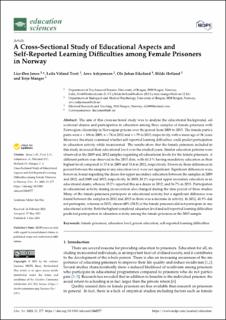| dc.description.abstract | The aim of this cross-sectional study was to analyse the educational background, educational desires and participation in education among three samples of female prisoners with Norwegian citizenship in Norwegian prisons over the period from 2009 to 2015. The female participants were n = 106 in 2009, n = 74 in 2012 and n = 79 in 2015, respectively, with a mean age of 38 years. Moreover, the study examined whether self-reported learning difficulties could predict participation in education activity while incarcerated. The results show that the female prisoners included in this study increased their educational level over the studied years. Similar education patterns were observed in the 2009 and 2012 samples regarding all educational levels for the female prisoners. A different pattern was observed in the 2015 data, with 44.3 % having mandatory education as their highest level compared to 57.6 in 2009 and 53.4 in 2012, respectively. However, these differences in percent between the samples at any education level were not significant. Significant differences were, however, found regarding the desire for upper secondary education between the samples in 2009 and 2012, and 2009 and 2015, respectively. In 2009, 20.2% reported upper secondary education as an educational desire, whereas 35.2% reported this as a desire in 2012, and 36.7% in 2015. Participation in educational activity during incarceration also changed during the time period of these studies. Many of the female prisoners participate in educational activity, but a significant difference was found between the samples in 2012 and 2015 as there was a decrease in activity. In 2012, 41.9% did not participate, whereas in 2015, almost 60% (58.2) of the female prisoners did not participate in any educational activity. Both the highest completed education level and self-reported learning difficulties predicted participation in education activity among the female prisoners in the 2015 sample. | en_US |

